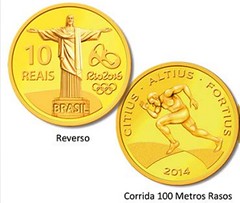
PREV ARTICLE
NEXT ARTICLE
FULL ISSUE
PREV FULL ISSUE
BRAZILIAN CENTRAL BANK'S BIG COIN LAUNCHRodrigo de Oliveira Leite writes:
The first problem is the number of different coins sold all at once, 13 is a very big amount of different coins for the Brazilian market, in recent years there were only three or four coins released each year. Early this year 9 coins were released to celebrate the FIFA World Cup (six R$2 coins in Copper-Nickel, two Silver Proof R$5 coins and a gold R$10 coin). Only two out of the nine coins were an outstanding success: the R$10 gold one and the R$2 themed “The Goal”. For a market that used to have only a handful of coins for collectors released each year, 22 coins in a single year is a very big number. The second problem is the price, for a coin that has only 27 grams of 90% silver the price is very high: US$76,00. This is a problem also with the gold coin: 4,4 grams of 90% gold for US$460,00. The R$1,00 in a Brilliant Uncirculated blister is more affordable: US$5,00 each. And of course the R$1,00 coins will be available for R$1,00 (40 cents, today’s price). For a collector to buy all the coins, he or she will pay US$788,00, a very big amount of money when converted to Reais. Also, the Coins will be sold only in 10 cities across the country: if you don’t live in those cities, tough luck, you will have to buy from the Brazilian Bank website (that usually runs out of stock in hours), or at your local coin dealer. But if a person buys at a coin dealer, he or she will spend almost US$900,00, making the complete set even harder to accomplish. That’s the challenge: how to sell those overpriced coins to a market that is not accustomed to receive a big amount of coins each year? The answer may be very difficult for the Brazilian government to find. The U.S. Mint's coin programs are gargantuan. It's been many years since the typical collector could even dream of affording
all of the yearly issues. Mints become addicted to the revenue, and push the limits further and further each year. This is a worldwide problem.
Welcome to the club, Brazil! -Editor
Wayne Homren, Editor The Numismatic Bibliomania Society is a non-profit organization promoting numismatic literature. See our web site at coinbooks.org. To submit items for publication in The E-Sylum, write to the Editor at this address: whomren@gmail.com To subscribe go to: https://my.binhost.com/lists/listinfo/esylum All Rights Reserved. NBS Home Page Contact the NBS webmaster 
|
